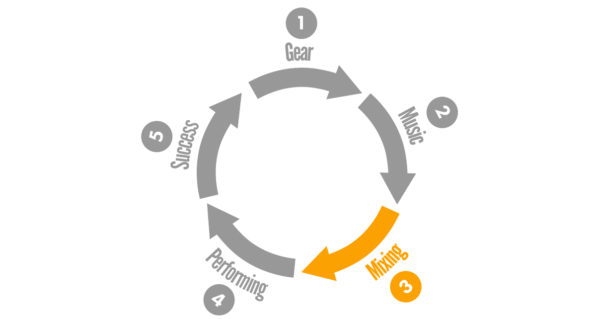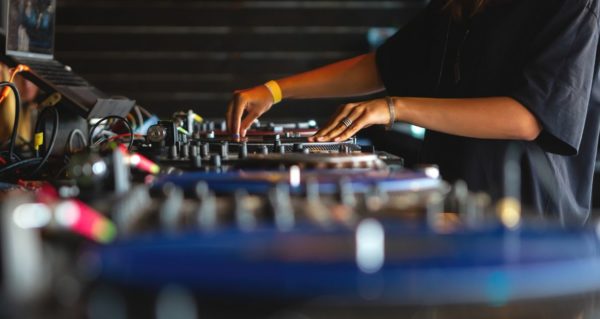So you want to be able to DJ like a pro, but it’s hard to know where to start, it’s hard to know what to practise, and it’s hard to know if you’re getting better.
This proven five-step formula, first popularised in our book Rock The Dancefloor! (which has now reached its second edition and is a global bestseller), is your answer.
Video podcast
Prefer your podcasts to be a bit more visual? Watch the video version here, where you’ll learn more about mixing, the third step in our proven formula for DJing success.
Here we’re going to look at step three, which is mixing, before moving on to look at the next two steps in order (the order is important). We’ve already covered the first two steps, gear and music.
You’ll find a YouTube video where I give you extra thoughts, and a podcast version as well, which you can subscribe to – do this now, so you don’t miss any of them.
You’ll learn plenty from the articles and accompanying video/audio to make solid improvements in your DJing, but if you want to learn more, we’ll direct you to a free online version of the book, and I’ll also explain what extra material is available in our course based on the book, The Complete DJ Course.
Why does this method work?
Each of the five steps in this teaching method identifies an area to work on. When you work in all areas, it has a “multiplier effect”. By approaching your DJing hobby this way, you’ll get noticeably better – fast – and you’ll have more fun doing so. You’ll find you’re never stuck for something to do, and your progress will be obvious, not least to you!
Step 3: Mixing
Mixing is what you do with the music you worked on in step two, using the gear we covered in step one.
A big mistake beginner DJs make when they want to learn to DJ is try to start here, at step three. As we’ve already seen, without a solid grounding in the first two steps, you’re going to come unstuck quite quickly, because either you’ll get frustrated with the gear and it will hold you back unnecessarily, or you’ll find you haven’t got the music you want (or you can’t find the music you want quickly enough) to make the mixing part fruitful.
However, if you understand and are also working on the first two steps, you’re ready for this one. And of course, it is this one that often ultimately draws DJs to the hobby, because we all see DJs doing a great job and want to emulate them.

Read this next: 8 Reasons Why Mixing Is Important For DJs
You know you need to work on this step when:
- You’re overwhelmed by the many ways mixing can be done today
- You see YouTubers and clips on Instagram or TikTok of DJs doing things that look ridiculously difficult to you, and it makes you feel inferior or overwhelmed
- You feel that unless you master stems or fuzzy keymixing or tone play or word play, etc, you won’t be able to call yourself a DJ – and that the bar is getting higher all the time
Our biggest tip
Every single thing I just spoke about – the countless ways of mixing, the choreographed 20-second clips you see online, the new creative features that didn’t exist a generation ago – assumes that you know the basics of counting beats, bars and phrases, and how manual beatmixing is done. These things have never changed, but without them, you’re lost at sea before you begin.
However, I have two pieces of extremely good news for you. Number one is that 80% of the DJ transitions you’ll want to do can be done with 20% of the skills, which are extremely easy to learn and which build easily on those basics. The other 20% is up to you – many DJs never move past the half dozen basic transitions, and have fine careers nonetheless.

And number two? There is absolutely no need to master old-fashioned manual beatmixing at all! Good news, right? But what’s important is that you understand it, because once you understand it, you can use all the tools that have been given to you to make your life as a DJ easier, that appear on all DJ gear nowadays, to make mixing easier. To be clear, manual beatmixing is a nice to have, but it is fine to take time to learn it, and it is a mistake to let “not yet being fluent” at manual beatmixing hold you back.
Audio version
Here’s what’s covered…
- 0:00 Intro
- 0:15 Episode overview
- 1:09 Where beginner DJs get stuck..
- 2:41 Tip #1 – Get the volume right
- 4:30 Tip #2 – Noticeable mixing is OK
- 7:33 Tip #3 – There’s no “correct” way to DJ
- 11:09 Bonus tip – Record your sets
Find Out More
The third section of our Rock The Dancefloor! book deals with this step, with chapters covering the basic DJing technique, understanding your mixer, understanding your decks, the importance of timing, the three elements of a good beatmix, five basic DJ transitions, using sync, hot cues and loops, adding EQ, filter and effects, and how to record and critique your DJ sets. Go here to access the book for free.
Ready to take the next step? With 21 video lessons dedicated to this area, you can join me as I teach you all of this and more inside our all-new Complete DJ Course.





![Your 5 Proven Steps To DJing Like a Pro, Part 4: Performing [Summer School Podcast] Your 5 Proven Steps To DJing Like a Pro, Part 4: Performing [Summer School Podcast]](https://cdn.digitaldjtips.com/app/uploads/2024/07/18215143/summerpodcastfeat-150x150.jpg)
![DJ Lighting, Using Headphones Only, Trance Mixing [Podcast] DJ Lighting, Using Headphones Only, Trance Mixing [Podcast]](https://cdn.digitaldjtips.com/app/uploads/2024/03/20175506/podcastwebsiteidea-150x150.jpg)
